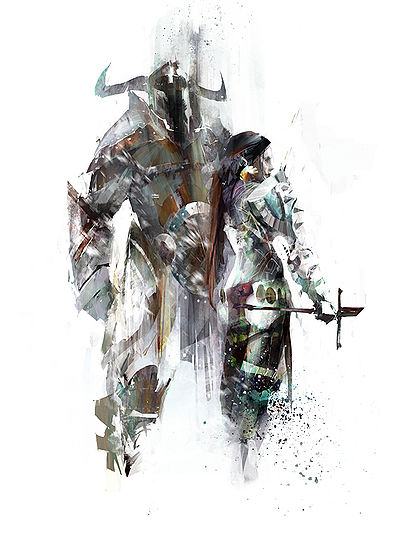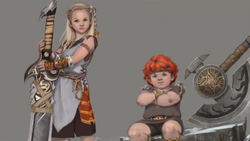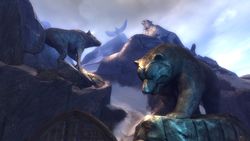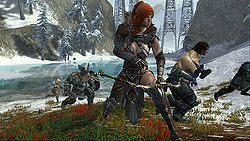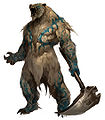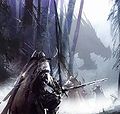Norn
“This race of towering hunters experienced a great defeat when the Ice Dragon drove them from their glacial homeland. Nevertheless, they won't let one lost battle—however punishing—dampen their enthusiasm for life and the hunt. They know that only the ultimate victor achieves legendary rewards.
— In-game description
The norn are a 9-foot (2.74 m) tall race originally from the Far Shiverpeaks, although their conflict with the Elder Dragon of Ice and Persuasion, Jormag, has forced them to the central Shiverpeaks, where they currently live. The individualistic norn live for the hunt, their tracking, stealth, and killing skills make them invaluable allies in any combat situation. The norn are very proud of their personal victories, and their main goal in life is to achieve great things to cultivate their legend. The biggest norn settlement is the Great Lodge of Hoelbrak.
The norn are one of the five playable races in Guild Wars 2.
Character creation[edit]
During character creation, a player can customize a norn's physical appearance and answer three race-specific biography questions which affect their personal story:
- What is the most important quality of a great hero.
- What happened at a recent celebratory moot held in Hoelbrak.
- Which of the four main Spirits of the Wild offered its guardianship to them.
Selecting a norn character will start players off in the tutorial The Great Hunt, where the players gather trophies to prove their worth and cultivate their legend. After finishing the mission, they will appear in Snowlord's Gate, the starting area in Wayfarer Foothills.
The norn home instance is in the Hunter's Hearth, part of The Great Lodge of Hoelbrak.
Most norn racial skills are thematically related to the Spirits of the Wild, capitalizing on the norn's ability to shape-shift into animal forms.
Physiology[edit]
The norn largely resemble humans. However, they are noticeably taller (around nine feet or 2.75 meters), and they are able to shape-shift into animal forms, were-creatures that resemble the animals the Spirits of the Wild represent. In their humanoid forms, their proportions are much broader and more heavily muscled than a typical human. Thrulnn the Lost describes the norn as being giants, along with the Jotun. Norn can also have long lives, living up to 120 and maintaining their good health and vitality for a long time, though very few die of old age[1].
Norn have a broad range of skin colors, light-skinned norn living in Lion's Arch will have their skin easily tanned by the sun. According to Kranxx, norn generate a considerable amount of body heat at the slightest exertion.
While shape-shifting, norn take on an upright half-norn half-animal form, known as Spirit Form, resembling one of the animals the Spirits of the Wild represent. The were-form is furred, fanged, and clawed, and grants the norn attributes depending on the animal they transform into.
The transition between norn and were-form is described as a blur. The blur then transfigures into a more solid appearance over a short period of time, revealing the were-form. Any clothing or armor worn by the norn is covered by the form, and therefore not visible. While the transformation is generally stronger and more durable, wounds and poison do not appear to be cured by this shape-shifting.
Although it is implied by some norn in Guild Wars that the norn are able to interbreed with humans, norn-human hybrids are not possible because the five main races cannot cross-fertilize each other.[2]
Culture[edit]
Norn culture is highly individualistic with a focus on personal success and glory—particularly when gained from the hunt or in a battle. The norn do not fear death, as they believe the bold and strong can achieve immortality, but they do fear they will be weak and end up forgotten. As a result, each norn seeks to prove themselves, to build their legend through feats of individual valor and great victories. Every norn hopes their legend will be told by a skaald, celebrated at a moot, and remembered forever through story and song. Norn usually have a great sense of personal honor, for a norn without respect from others is already forgotten. For many norn, the focus on prestige means they're willing to accept any challenge which will prove their worth. They will never give up on their battle, quarry or friends, even if it means years spent tackling a strong enemy or difficult task. Nevertheless, to some norn the pursuit of prestige translates to bragging, bullying, unwise snap decisions, and an unwillingness to listen to reason.
Norn are a hearty, proud people—quick to anger but then quick to forgive. They are, by their nature, a race of optimists, keeping a positive outlook even though they have been driven from their homelands. A setback is seen as just another challenge to overcome. They respect those who can best them in a fight, so brawling among norn is common. Drinking alcohol, often to excess, is also a large part of norn culture. Being drunk and fighting is not an uncommon combination, for example, norn alemoots feature competitions of 'skill' which require the competitors to be very drunk to compete.
In modern times, the norn hold an annual grand moot, called the Great Hunt. The Great Hunt features a dangerous beast for fighters and hunters to try to kill, as well as what is usually at a typical moot. In order to join in on the Great Hunt, a norn must prove themselves worthy by presenting a trophy from a recent kill. The norn also hold, at least historically, a specialized moot called an alemoot, which specializes in testing how much one can drink and still complete an obstacle course of sorts.
A norn might proudly trace their worthy ancestors through many generations and may pass a common name through a family (such as Olaf Olafson, seventh son of Olaf) but a great ancestry and family connections do not grant automatic respect to a norn. Everyone is judged not by their lineage or associated group, but by what deeds they have done. As a result, the norn are often tolerant of an individual to whom other races might treat with hostility by association, for example the Sons of Svanir are, to some extent, tolerated. There is no such thing as infamy to the norn. For example, a norn who achieves respect from their peers through deeds that might be considered "underhanded" by human standards has still accomplished what the norn value most, and is seen as equal to a norn who has performed more "respectable" acts.
Norn are known to marry, but only if the couple is of equal status. During the wedding, someone must speak on behalf of the couple in order to show that they are a worthy match for each other.
Despite the cold weather of the Shiverpeaks, the norn are often only lightly clad, exposing skin which is frequently covered in elaborated tattoos in Scandinavian/Norse style motifs.
Religion[edit]
The norn have a shamanistic religion, revering the mysterious Spirits of the Wild, beings that embody the strongest, bravest, wisest, or most cunning animals of the Shiverpeaks. The Great Spirit is Bear, who is seen as the strongest of all the spirits and is said to have granted the norn the ability to 'become the bear'. Snow Leopard, Raven and Wolf are, together with Bear, the four Great Spirits of the Wild, and are highly revered because of the assistance they gave the norn in the past on their exodus to the south, away from Jormag. There are many other Spirits, such as Ox, Eagle, and Wurm, but they are not as widely revered.
Each spirit has any number of shaman. A shaman devotes themselves to a spirit, serving as guardians to places where that spirit is venerated, and teachers of the lessons of that spirit. The four most important spirits have huge Spirit Lodges built in their honor in Hoelbrak; these are governed by the most powerful shamans, the Speakers of Hoelbrak. Each Spirit has a havroun, a powerful norn shaman with a connection to the Spirit through the Mists. The powerful Havrouns are capable of transcending to the Mists and even take allies with them in that journey.
As with other aspects of their lives, the norn take an individual approach to their religion. Groups of norn, such as families, larger lodges, or isolated homesteads tend to revere a particular Spirit over the others, calling forth its special attributes so they might emulate it. This means that some Spirits are more widely revered in some places than in others. On rare occasions, tension may arise between the followers of some spirits; for example, followers of Bear might see Raven's approach as deceptive and therefore weak and dishonorable. It is important to note that, while a norn may focus on revering one Spirit over another, all norn acknowledge the existence of all the Spirits, even if they do not revere all those Spirits, or consider some of them weak.
The norn may ask the Spirits of the Wild for help, calling on them in battle and using their shape-shifting abilities to better connect with them. Although the Spirits rarely directly help the norn, when they do, they provide impressive advantages. Despite the rare direct intervention of the Spirits, the norn often call upon them when hunting, and believe that if the Spirit did not help them, is because it knew its help was not needed.
While they do not worship or revere the Six Human Gods, they do acknowledge them and their power. However, they do not refer to them by the names humans give them; instead, they refer to them as the "Spirits of Action" as a whole and by what they govern individually; for example, Balthazar is War, and Kormir is Knowledge.[3]
Government[edit]
The norn do not have a central government or nation. Most norn resist submission, and will not kneel before anyone. The closest thing to leadership comes from the respect gained from other norn by those who have performed significant, widely recognized heroic deeds. Those norn with exceptional strength and prowess in battle might establish a homestead, but they are not considered rulers of those living within it.
That said, the Great Lodge of Hoelbrak is ruled by Knut Whitebear, a descendant of Asgeir Dragonrender, the founder of Hoelbrak. Knut is accepted by all as the master of Hoelbrak, and he is expected to keep the city safe. He is known to keep order in the settlement and has had to kick troublemaker Sons of Svanir out at times, although he does offer forgiveness to foolish young norn if they apologize and recognize their mistakes. Knut's sons—Sigfast and Skarti—lead the Wolfborn, a group of norn volunteers that vouch to keep peace in Hoelbrak.
Names[edit]
Most norn follow a Northern European or Viking-style first name system, though some like the famous explorer Captain Romke and his crew have Dutch and Frisian names.
Their surnames can vary in a multitude of styles. Norn without any achievements or legends have surnames after one of their parents (father/mother's first name followed by -sson, -sdottir, -kin or a variant thereof); this is most commonly seen in children, and they're named after the more famous of their parents even if they do not like said parent (e.g., Braham Eirsson). Surnames do not get adopted from generation to generation, and they can be changed by the individual to fit their own personal legend (e.g., a famous Wolfborn member took the surname Wolfsdottir); married couples may not always share surnames either (though some may, e.g., Knut and Gaerta Whitebear). Some norn may also take titles instead of a surname if it fits them and their legend more (e.g., Borje the Sun Chaser).
History[edit]
Little is known of the history of the norn before they were first encountered in Guild Wars: Eye of the North.
The origin of the norn race isn't known, but there are theories. The kodan believe the norn may be descendants from an ancient Kodan group who disobeyed Koda's word during The Dragonstorm and abandoned the kodan to go hunting to the south.
This contradicts the norn belief that their ability to shapeshift was granted to them by the Bear. It isn't clear which—if either— of these, is true. Thrulnn the Lost, a jotun storyteller, claims that jotun and norn once ruled the Shiverpeak Mountains during an "Age of Giants," but both races fell from their supremacy; the norn at this point turned to the Spirits of the Wild who helped them stabilize their culture, while the jotun fell into a primitive nature.
The norn have always been a nomadic people, focused on hunting, individual goals, and pursuits. For a brief while, the norn were united as a race in the years after they assisted with the downfall of the the Great Destroyer in Guild Wars, but it did not take them long to revert to a nomadic, individualistic lifestyle. This did not stop them from convincingly holding their lands in the Far Shiverpeaks against invading charr warbands. Their defense earned the respect of the charr, and something of a cooperative peace emerged from their mutual respect for each other which has lasted for 200 years.
As early as 1078 AE, the still dormant Elder Dragon Jormag's influence was already being felt among the norn. Svanir was the first to hear Jormag's call, becoming permanently transformed into an ice bear form until his death. But, over the years, many followed Jormag's call and Svanir's footsteps, forming the Sons of Svanir, a cult dedicated to worshiping Jormag as the ultimate Spirit, the most powerful Spirit of the Wild whom they call Dragon, and venerate it in hopes of it one day killing all the other Spirits for being weak, along with weak norn; although Jormag is—of course— not a Spirit of the Wild.
In 1165 AE, Jormag awoke in the Shiverpeaks, raising and transforming creatures of ice and snow to serve him, the Icebrood. The norn were fierce, but Jormag was fiercest and, seeing as they could not hold their homes and hunting grounds, felt forced to travel south—with the guidance of some of the Spirits of the Wild— into the mountains abandoned by the dwarves. Here, they established new homes, and claimed new hunting grounds. But these mountains are not safe, either. The dredge also live in these lands, and they will fight hard to make sure they are never enslaved again, which often translates as attacks against norn, and kodan. The norn and the kodan are neither allies nor enemies, although some norn have at times been close to some kodan, such as Captain Romke.
Gallery[edit]
Screenshots[edit]
Concept art[edit]
Paintings[edit]
Renders[edit]
Trivia[edit]
- The "Nornir" (singular "Norn") are three female characters of Norse mythology who weave the fates of all living things represented as threads on a spindle. It was believed by the Norse that no one could change the destiny that the Nornir had woven for them, not even the gods, and that a Norse warrior was free to act however they saw fit to make their legend because it had already been ordained. This resulted in a very individualistic and honor-centered culture.
- During development, the three virtues used to inspire the stories and racial personality of the norn were independence, legend, and passion.[4]
See also[edit]
| The Guild Wars Wiki has an article on Norn. |
External links[edit]
- Norn Clothing Art Direction, KristenPerryArt.com
- Norn Week promotional blogs
- Legend and Legacy – The Norn in Guild Wars 2, ArenaNet Blog (archived)
- Norn Week – Designing and Redesigning Events, ArenaNet Blog (archived)
References[edit]
- ^ Ramblings from the Meet & Greet, CVV Gamer Blog
- ^ PAX Day 2! – From a Roleplayer's Eyes
- ^ Lore interview with Jeff Grubb, GuildMag
- ^ PAX Chat With Jeff Grubb, KillTenRats.com
